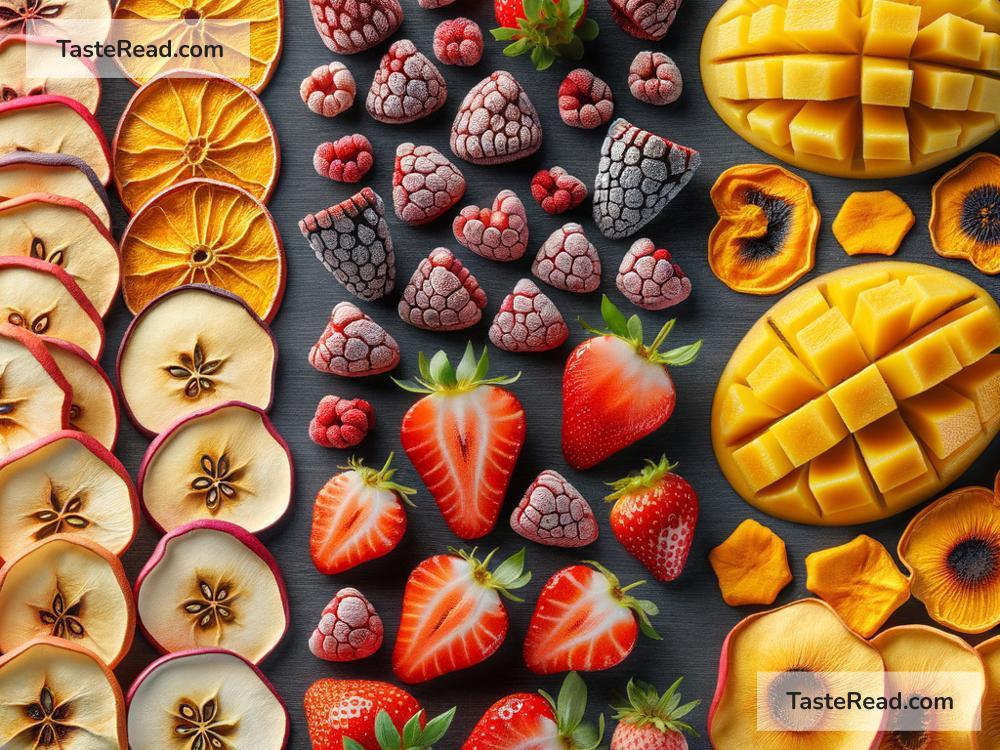How Drying Methods Impact the Flavor Concentration in Fruits
Drying fruits is one of the oldest methods of preserving food. Thousands of years ago, people dried fruits under the sun to prevent them from spoiling. Today, we have advanced drying techniques, but the goal remains the same: to remove moisture so the fruits can last longer. What many people don’t realize is that drying fruits does more than just extend their shelf life—it also changes their flavor. The way fruits are dried can either enhance their natural sweetness or make flavors less appealing. In this blog, we’ll explore how different drying methods influence the flavor concentration of fruits and what makes certain approaches ideal for taste.
Why Remove Moisture from Fruits?
Fresh fruits contain a lot of water—normally 70% to 90% of their weight is made up of moisture. This water is what makes fruits juicy, but it is also why they spoil quickly. Microorganisms, like bacteria and fungi, thrive in moist environments. By drying fruits, we remove most of the water, making it harder for these microorganisms to grow. But when you take out water, something else happens: the flavors become more concentrated.
Think of it like reducing a sauce while cooking. As the liquid in the sauce evaporates, the flavors become richer and stronger. Similarly, drying fruits intensifies their natural sugars, acids, and aromas. Depending on the method used, this process can bring out the best—or worst—of the fruit’s flavor.
Common Drying Methods and Their Impact on Flavor
There are four main methods for drying fruits, and each affects the flavor in a unique way:
1. Sun Drying
Sun drying is the most traditional method of drying fruits. It involves placing fruits under direct sunlight for several days. This method is simple, energy-efficient, and ideal for warmer climates. Raisins, figs, and apricots are commonly dried this way.
Impact on Flavor:
The slow drying process allows the natural sugars in fruits to concentrate steadily. Sun-dried fruits often have deep, caramel-like flavors because they are exposed to heat over time. However, because the drying process is outdoors, the fruits may be exposed to dust, insects, or uneven drying. This might slightly affect their taste or texture.
2. Oven Drying
Oven drying is a convenient way to dry fruits at home. Fruits are placed in an oven at a low temperature (around 140°F to 200°F) and left to dry for several hours. This method is faster than sun drying and offers more control over the drying environment.
Impact on Flavor:
Since oven drying uses heat, it can enhance sweetness and create slightly roasted, nutty undertones in fruits. However, if the temperature is too high, delicate flavors may be lost. For example, oven-dried apples may taste sweeter but lose some of their original tartness.
3. Dehydrator Drying
Food dehydrators are specialized machines designed to remove moisture from fruits and other foods. They use low, even heat and circulating air to achieve the perfect drying conditions. This is the most popular method for drying fruits at home or commercially.
Impact on Flavor:
Dehydrators preserve the natural flavors of fruits better than other methods. Because they use gentle heat, the sugars and acidity stay balanced, making the fruits taste as close to their fresh version as possible—only sweeter and more concentrated. For example, dehydrated mangoes retain their tropical sweetness without becoming overly sticky or burnt.
4. Freeze Drying
Freeze drying is a highly advanced method that involves freezing the fruit first and then removing the moisture through a process called sublimation, where ice turns directly into vapor without melting. This method is used commercially for drying fruits like berries, bananas, and apples.
Impact on Flavor:
Because freeze drying happens at low temperatures, the fruits retain much of their original flavor, texture, and nutrients. Freeze-dried fruits often taste lighter and crispier than those dried with heat, but their flavor is still concentrated. For example, freeze-dried strawberries have an intense berry flavor that’s less sugary than those dried with heat.
Factors That Affect Flavor During Drying
Aside from the drying method, several other factors influence flavor concentration in dried fruits:
- Ripeness: Fruits that are dried at their peak ripeness will have the best flavor. Overripe or underripe fruits may taste dull or overly sour when dried.
- Drying Time: The longer fruits take to dry, the more their flavors develop. Quick drying methods can lead to bland or unbalanced flavors.
- Temperature: High temperatures speed up drying but can destroy delicate flavors. Low and steady temperatures are better for preserving taste.
- Fruit Type: Some fruits, like mangos and peaches, naturally become sweeter when dried, while others, like cranberries, may still retain tartness.
What’s the Best Method for Flavor?
There’s no one-size-fits-all answer to this question—it depends on the fruit and personal preference! If you love bold, caramelized sweetness, sun drying is a great option. For fresher, more balanced flavors, dehydrators and freeze drying are better choices. Oven drying works well when you need to dry fruits quickly, but you’ll need to be careful with the temperature.
Conclusion
Drying fruits is as much about flavor as it is about preservation. Removing moisture intensifies the natural sugars, acids, and aromas in fruits, creating a delicious burst of taste. Whether you prefer chewy sun-dried apricots or crisp freeze-dried strawberries, the drying method you choose plays a huge role in the final flavor. Next time you enjoy a dried fruit snack, take a moment to appreciate the process behind its unique taste!


